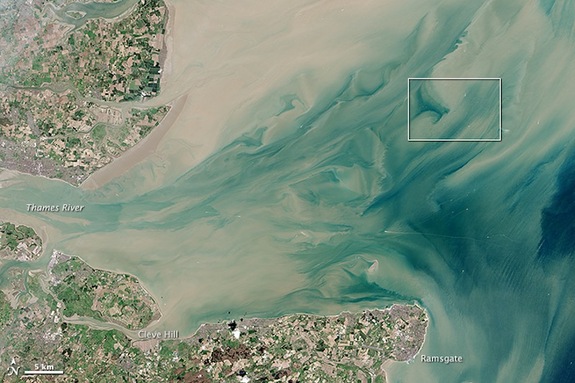World's Largest Offshore Wind Farm Seen From Space

Giant wind turbines appear as white specks across the Thames Estuary in the United Kingdom, in this satellite photo of the London Array, the world's largest offshore wind farm, released today (Jan. 21).
The wind farm, which became operational on April 8, 2013, is located 12 miles (20 kilometers) from England's Kent and Essex coasts. The London Array's 175 wind turbines can generate a maximum of 630 megawatts of power, which is enough to power 500,000 homes, according to NASA officials.
The Landsat 8 satellite, operated jointly by NASA and the U.S. Geological Survey, captured this image of the London Array on April 28, 2013. The white dots visible in the photo are wind turbines, and the wakes of several boats can also be seen. [Earth from Above: 101 Stunning Images from Orbit]
Tan-colored sediment swirls through the waters of the Thames Estuary, located where the River Thames meets the North Sea. The sediment is runoff washed out by the River Thames, NASA officials said.
The London Array's wind turbines are spread out across 40 square miles (104 square kilometers), each positioned to harvest the prevailing southwest wind. The turbines are separated by roughly 2,100 to 3,900 feet (640 to 1,200 meters), and stand 482 feet (147 m) tall. Cables buried beneath the seafloor connect the wind turbines and transmit power to two offshore substations and one onshore station, according to NASA officials.

The London Array's wind turbines sit on two natural sandbanks, where water can reach depths of 80 feet (25 m). This site in the Thames Estuary was chosen because of its proximity to onshore power grids and because it does not disrupt shipping lanes that cut through the area.
Construction of the next phase of the London Array is currently in progress, and the wind farm is expected to eventually grow to cover 95 square miles (246 square km).
Get the Space.com Newsletter
Breaking space news, the latest updates on rocket launches, skywatching events and more!
The London Array has been heralded as a way to reduce annual carbon dioxide emissions in the United Kingdom. Officials involved with the project say the wind farm could reduce carbon dioxide emissions by 900,000 tons, which is equivalent to the emissions of about 300,000 automobiles.
But, those critical of the London Array have expressed concern over the wind farm's impact on wildlife in the area, including red-throated divers and other bird species.
Follow Denise Chow on Twitter @denisechow. Follow LiveScience @livescience, Facebook & Google+. Original article on LiveScience.
Join our Space Forums to keep talking space on the latest missions, night sky and more! And if you have a news tip, correction or comment, let us know at: community@space.com.

Denise Chow is a former Space.com staff writer who then worked as assistant managing editor at Live Science before moving to NBC News as a science reporter, where she focuses on general science and climate change. She spent two years with Space.com, writing about rocket launches and covering NASA's final three space shuttle missions, before joining the Live Science team in 2013. A Canadian transplant, Denise has a bachelor's degree from the University of Toronto, and a master's degree in journalism from New York University. At NBC News, Denise covers general science and climate change.









